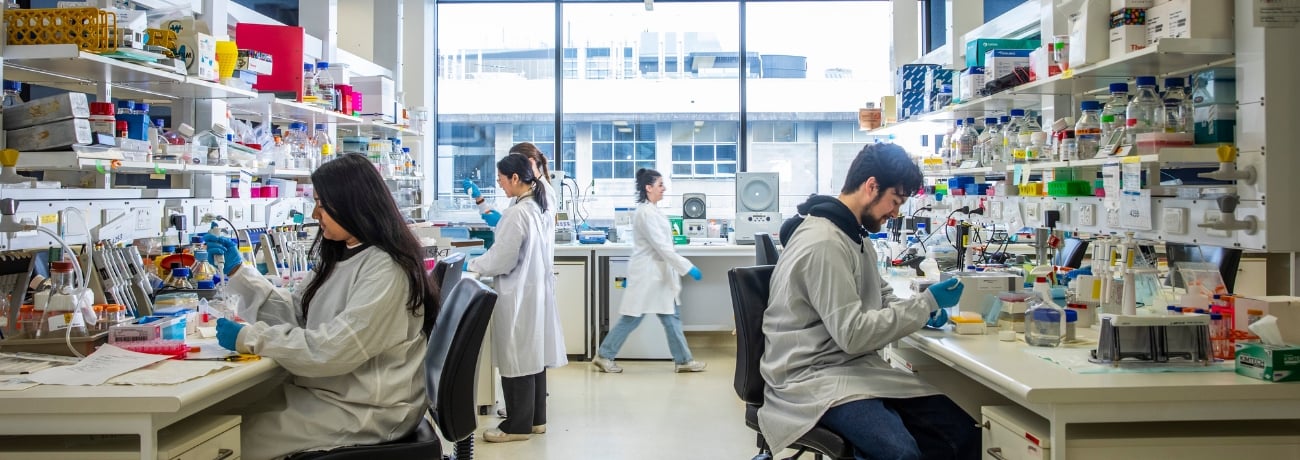Neuroepidemiology Group
Our group focuses on public health and neuroscience. We’re particularly interested in brain conditions that are becoming increasingly more common. Many of these have environmental drivers. These conditions include autism spectrum disorder, attention deficit/hyperactivity disorder and multiple sclerosis. We aim to generate new knowledge to allow better prevention or treatment of these conditions.
Research interests
|
Techniques
|
About our research
Our goal is to use population-based study data to gain a better understanding of conditions that affect the brain and spinal cord, and to identify points of intervention to reduce their risk onset and progression. Our work involves understanding how early environment affects brain development, and the genetic and environmental determinants of brain disease and disorders. In addition, we investigate underlying biological pathways and work towards improved preventative treatment strategies.
Research projects
- A two-hit hypothesis of neurodevelopmental disorders: exploring BDNF val66met polymorphism and environmental prenatal exposures
- Biological programming of child mental health in early life: understanding mechanisms and their timing
- Chemical exposures in utero, child neurodevelopment and epigenetic programming
- Plastic chemicals, lipidomics and child neurodevelopment
- Prenatal factors (emphasis on nutrition), one-carbon metabolism, epigenetic programming and early childhood neurodevelopment
Research team
Research team head
Professor Anne-Louise Ponsonby
Group Head
Team members
Senior Research Fellow
Research Officer
Senior Research Fellow
Research Fellow
Sarah Thomson
Alex Gruen
Data Scientist
Dhaval Parikh
PHD students
Alicia Bjorksten
PhD student
Alex Eisner
PhD student
Mehari Merid
PhD student
Lada Staskova
PhD student
Samuel Tanner
PhD student
Kristina Vacy
PhD student
Selected publications
- Symeonides C, Vacy K, Thomson S, Tanner S, Chua HK, Dixit S, Mansell T, O’Hely M, Novakovic B, Herbstman JB, Wang S, Guo J, Chia J, Tran NT, Hwang SE, Britt K, Chen F, Kim TH, Reid CA, El-Bitar A, Bernasochi GB, Delbridge LMD, Harley VR, Yap YW, Dewey D, Love CJ, Burgner D, Tang MLK, Sly PD, Saffery R, Mueller JF, Rinehart N, Tonge B, Vuillermin P; BIS Investigator Group; Ponsonby AL, Boon WC (2024), ‘Male autism spectrum disorder is linked to brain aromatase disruption by prenatal BPA in multimodal investigations and 10HDA ameliorates the related mouse phenotype’, Nature Communications, 15(1):6367, doi:10.1038/s41467-024-48897-8
- Butzkueven H, Ponsonby AL, Stein MS, Lucas RM, Mason D, Broadley S, Kilpatrick T, Lechner-Scott J, Barnett M, Carroll W, Mitchell P, Hardy TA, Macdonell R, McCombe P, Lee A, Kalincik T, van der Walt A, Lynch C, Abernethy D, Willoughby E, Barkhof F, MacManus D, Clarke M, Andrew J, Morahan J, Zhu C, Dear K, Taylor BV; PREVANZ Investigators (2024), ‘Vitamin D did not reduce multiple sclerosis disease activity after a clinically isolated syndrome’, Brain, Apr 4;147(4):1206-1215, doi:10.1093/brain/awad409
- Kepp KP, Aavitsland P, Ballin M, Balloux F, Baral S, Bardosh K, Bauchner H, Bendavid E, Bhopal R, Blumstein DT, Boffetta P, Bourgeois F, Brufsky A, Collignon PJ, Cripps S, Cristea IA, Curtis N, Djulbegovic B, Faude O, Flacco ME, Guyatt GH, Hajishengallis G, Hemkens LG, Hoffmann T, Joffe AR, Klassen TP, Koletsi D, Kontoyiannis DP, Kuhl E, La Vecchia C, Lallukka T, Lambris J, Levitt M, Makridakis S, Maltezou HC, Manzoli L, Marusic A, Mavragani C, Moher D, Mol BW, Muka T, Naudet F, Noble PW, Nordström A, Nordström P, Pandis N, Papatheodorou S, Patel CJ, Petersen I, Pilz S, Plesnila N, Ponsonby AL, Rivas MA, Saltelli A, Schabus M, Schippers MC, Schünemann H, Solmi M, Stang A, Streeck H, Sturmberg JP, Thabane L, Thombs BD, Tsakris A, Wood SN, Ioannidis JPA (2024), ‘Panel stacking is a threat to consensus statement validity’, Journal of Clinical Epidemiology, Sep;173:111428, doi:10.1016/j.jclinepi.2024.111428
- Vacy K, Thomson S, Moore A, Eisner A, Tanner S, Pham C, Saffery R, Mansell T, Burgner D, Collier F, Vuillermin P, O’Hely M, Boon WC, Meikle P, Burugupalli S, Ponsonby AL; Barwon Infant Study Investigator Group (2024), ‘Cord blood lipid correlation network profiles are associated with subsequent attention-deficit/hyperactivity disorder and autism spectrum disorder symptoms at 2 years: a prospective birth cohort study’, EBioMedicine, Feb;100:104949, doi:10.1016/j.ebiom.2023.104949
- Seewoo BJ, Goodes LM, Thomas KV, Rauert C, Elagali A, Ponsonby AL, Symeonides C, Dunlop SA (2024), ‘How do plastics, including microplastics and plastic-associated chemicals, affect human health?’ Nature Medicine, Nov;30(11):3036-3037, doi:10.1038/s41591-024-03287-x
- Thomson S, Drummond K, O’Hely M, Symeonides C, Chandran C, Mansell T, Saffery R, Sly P, Mueller J, Vuillermin P and Ponsonby A-L (2023), ‘Increased maternal non-oxidative energy metabolism mediates association between prenatal di-(2-ethylhexyl) phthalate (DEHP) exposure and offspring autism spectrum disorder symptoms in early life: a birth cohort study’, Environment International, 171:107678, doi:10.1016/j.envint.2022.107678
- Ponsonby A-L (2021), ‘Reflection on modern methods: building causal evidence within high-dimensional molecular epidemiological studies of moderate size’, International Journal of Epidemiology, doi:10.1093/ije/dyaa174
- Tanner S, Thomson S, Drummond K, O’Hely M, Symeonides C, Mansell T, Saffery R, Sly PD, Collier F, Burgner D, Sugeng EJ, Dwyer T, Vuillermin P and Ponsonby A-L (2022), ‘A pathway-based genetic score for oxidative stress: an indicator of host vulnerability to phthalate-associated adverse neurodevelopment’, Antioxidants, 11(4):659, doi:10.3390/antiox11040659
- Pham C, Bekkering S, O’Hely M, Burgner D, Thomson S, Vuillermin P, Collier F, Marx W, Mansell T, Symeonides C, Sly PD, Tang MLK, Saffery R and Ponsonby A-L (2022), ‘Infant inflammation predicts childhood emotional and behavioral problems and partially mediates socioeconomic disadvantage’, Brain, Behavior, and Immunity, 104:83–94, doi:10.1016/j.bbi.2022.05.011
Contact us
For more information about our group’s research you can contact us by submitting this form.
